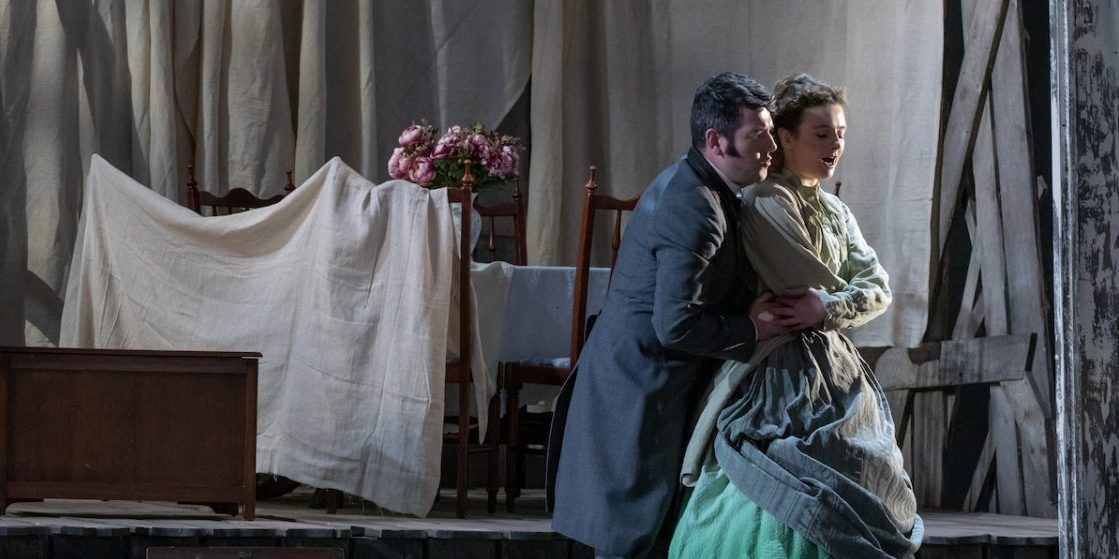‘The perfect summer came to pass, but not to stay.’ This line from near the end of Mark Adamo’s contemporary opera captures the key theme of this coming-of-age drama based on the iconic nineteenth-century novel by Louis M. Alcott. The four March sisters are moving from adolescence into the world of adult choice, and are torn between preserving the perfect sisterhood they have enjoyed hitherto and making independent moves into new relationships and the fresh dimensions of marriage and work. Should a change be opposed or embraced? Was that past really as perfect as it seemed to some? Does fulfillment lie in work or in the family? These are some of the themes set out in this adaptation, which manages to be both faithful to the original and an independent work of art.
While the opera was first seen in the USA in 1998, this is its British premiere, and it is hard to see how it could be better presented to the public here. Musical, dramatic, and creative values fuse to present a long but continuously engrossing evening. The score is accessible and through-written, but with recognisable solo arias and orchestral commentaries. The libretto is skilfully adapted by the composer, though perhaps a bit too much scene-setting makes Act One a tad too long. Act Two on the other hand moves past in a sustained sweep of impressive action, with an ambiguous ending that is in some ways an improvement on the more conventional conclusion to the novel.
The four sisters represent four archetypes or temperaments that respond differently to common challenges. As Jo, the sprightly independent-minded writer determined not to marry, Charlotte Badham has the most demanding role, given that she is on stage leading the action for most of the time. She provides excellent leadership for the cast in both acting and singing, truly embodying the role’s feistiness and complexity. Kitty Whately, as Meg, the first sister to ‘break ranks’ and marry, strikes an independent note, making the most of her vocal opportunities and standing up to her sister well. As Amy and Beth, Elizabeth Karani, and Harriet Eyley, are less fully characterised, but come into their own in the second half where their own choices and emotions are given greater prominence. The important role of the spinster, Aunt March, representing the views of an older generation, is delivered with no-nonsense crispness by Lucy Schaufer.
There is less for the men to do but the three prospective husbands are all accorded distinctive arias to deliver involving considerable technical challenges. As Laurie, the kindly neighbour devoted to Jo, Frederick Jones has an initial puppyish charm which develops into a more mature graciousness by the end; Harry Thatcher, as Laurie’s tutor, generates a fine wave of romantic tone to woo Meg; and Benson Wilson delivers a rich reworking of one of Goethe’s most famous lyrics to finally win over Jo.
In the pit, Sian Edwards negotiates a complex score with skill and all departments of the ever-reliable City of London Sinfonia acquit themselves with delicacy and panache, as needed. The design team has ingeniously devised a set that is shared with the Delius/Puccini double bill including elements that flexibly disassemble as needed. It was a fine idea to produce four picture frames for each of the sisters, with action taking place, as needed in each. This not only turns the potentially problematic width of the Holland House stage to the best advantage but also allows us to focus on the problems and concerns of each sister in sequence. A quartet of female singers, one for each sister, acts as an on-stage chorus, presiding in each of the four frames. Designer Madeleine Boyd has placed these women in a modern dresses while everyone else is in impeccable period outfits.
It seems hard to explain that this fine work has taken over twenty years to reach these shores and the director, Ella Marchment, deserves great credit for introducing it to us in such fluent and dramatically effective terms. This is a very wordy opera, but it is a testament to the director’s skill that the production is constantly on the move with excellent use made of the forestage walkway around the orchestra pit and a flurry of convincing, in-character, stage business to engage the eye. This should be the first production of many, one hopes, of this excellent work.

